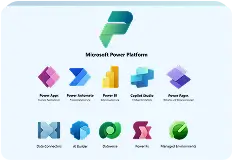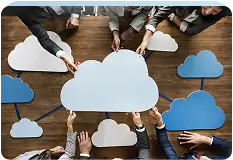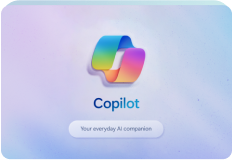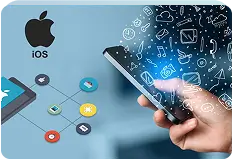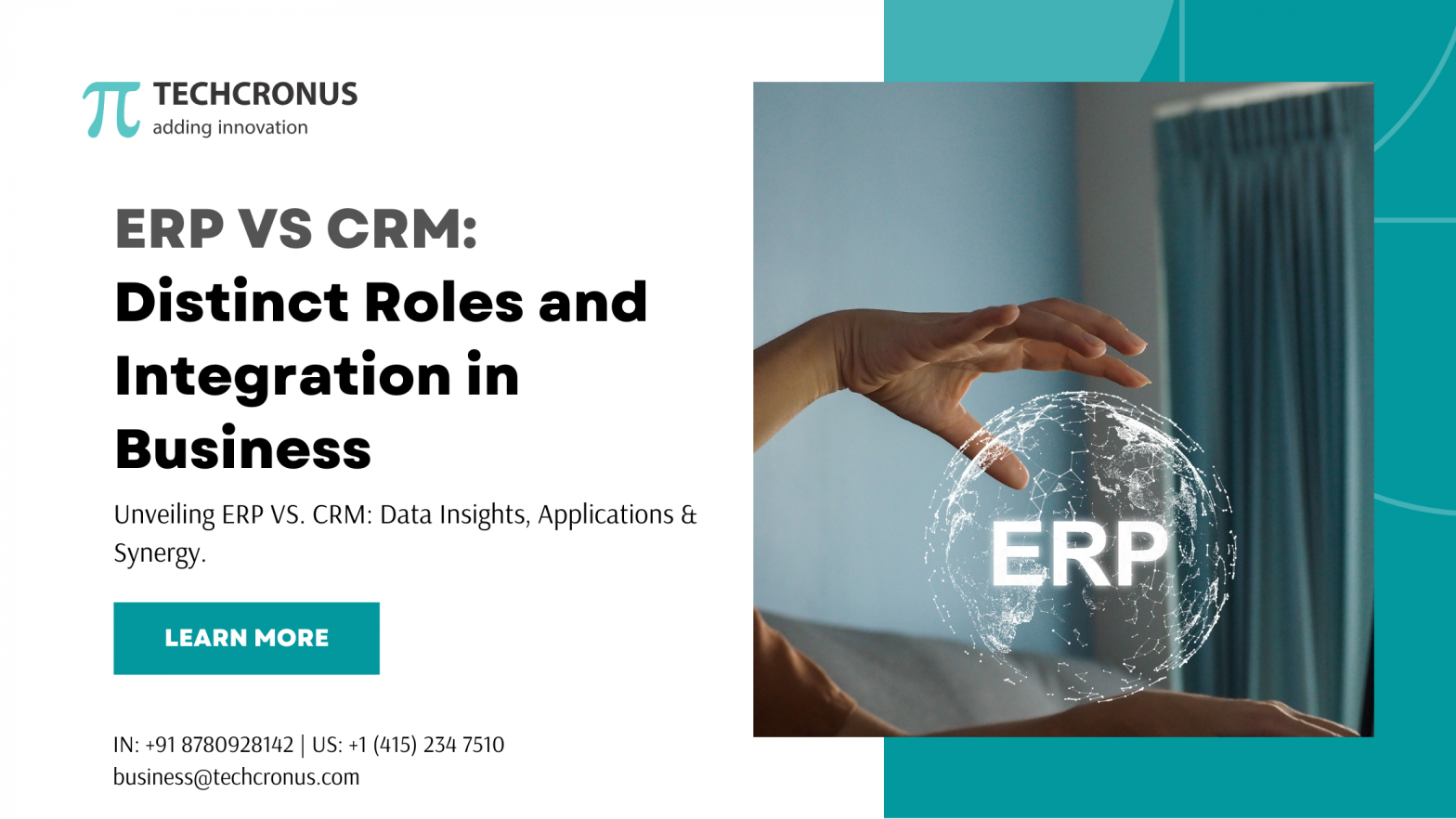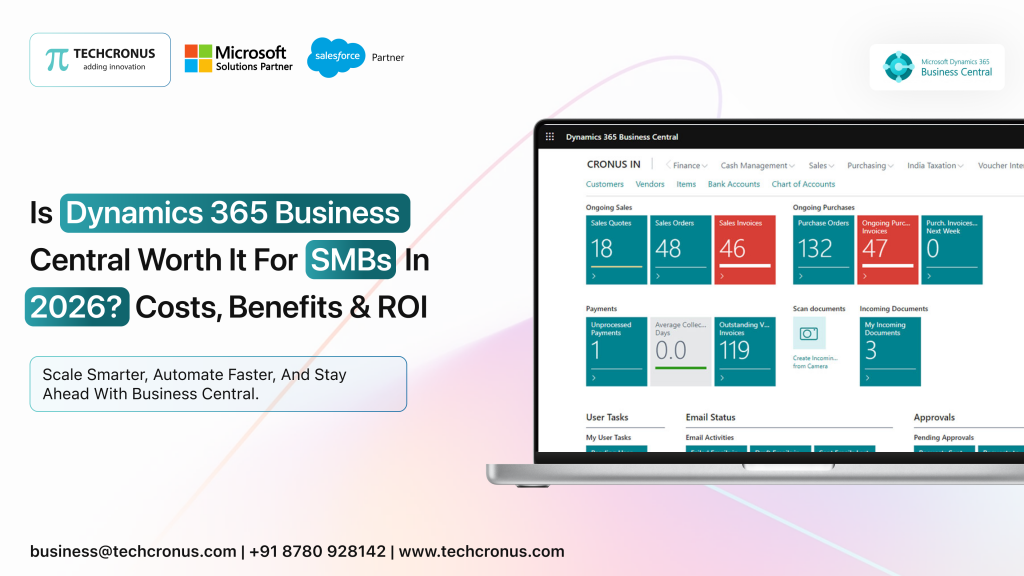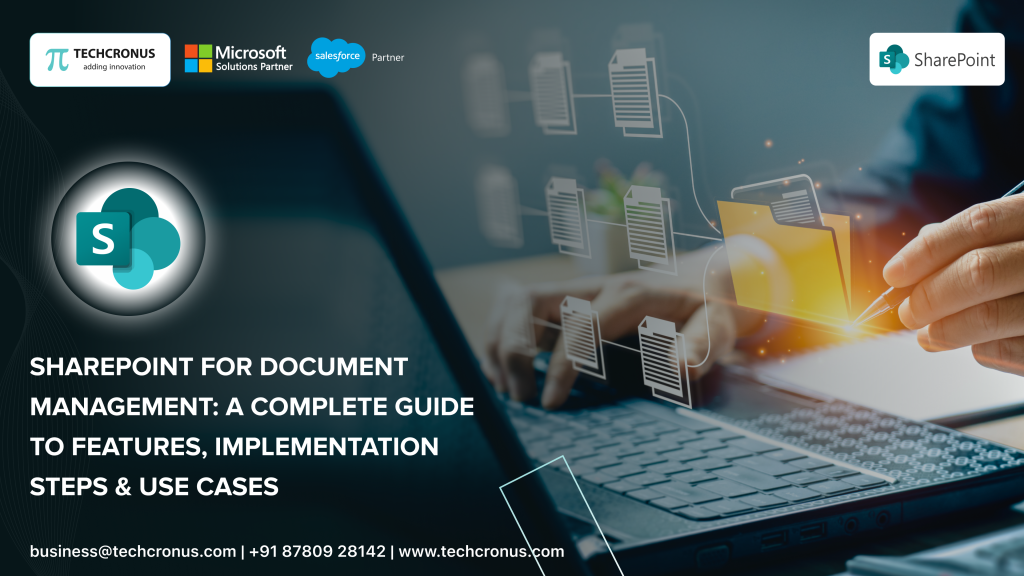Table of Contents
Introduction To ERP & CRM:
ERP or Enterprise Resource Planning refers to a comprehensive software solution designed to streamline and integrate core business processes within an organization. Sounds difficult? Let’s break this definition down. Basically, Enterprise Resource Planning is a platform that helps manage all your business-related functions in one place. Whether it is finance, human resources, supply chain management, inventory control, or manufacturing, ERP has your back.
The core functions of ERP are as follows.
- Financial management
- Supply chain management
- Human resource management
- Optimizing manufacturing and operations
Next, let’s talk about CRM and what it is all about. To put it simply, Customer Relationship Management (CRM) systems manage interactions and relationships with customers (and, of course, your potential customers, too). So, with CRM, you can centralize all your customer data and track your customer interactions. It can also help you analyze customer behavior to improve engagement and foster long-term relationships.
Now that you understand what CRM is, let’s talk about its core functions and what it can do for you.
Here’s a quick list of CRM’s core functions:
- Contact management
- Sales automation
- Marketing automation
- Customer service and support
Next, let’s discuss the importance of differentiating between ERP and CRM.
You can explore the ERP Fundamentals here.
The Importance of Differentiating ERP and CRM in Business Operations
You might be wondering why it is so important to differentiate ERP and CRM. First, when you can differentiate between the two, you can implement the right solution for the right purpose. It will also help you improve your business’s performance as you get a more holistic view of your business. You can improve customer relationships and make better, well-informed decisions. So, understanding the difference between the two and implementing the right solution means better business growth.
Curious about the exact differences? Let’s get started. Deep Dive into ERP Systems
Overview of ERP: Operational Focus and Internal Process Management
As we’ve discussed, ERP is a software suite designed to manage and integrate numerous internal business operations across various departments. Think of it as the central nervous system, connecting, streamlining, and optimizing how different parts of your company function.
Next, let’s discuss the key components of ERP and how they work.
Key Components of ERP: Supply Chain, Finance, HR, and Inventory Management
Supply Chain Management:
One of the main components of ERP is supply chain management. To put it simply, ERP manages the flow of goods and materials from suppliers to production to customers. Basically, ERP systems help optimize the supply chain by automating procurement, inventory management, and logistics.
Finance Management:
Apart from supply chain management, ERP systems also help with finance management. They consolidate financial data from across the organization for accurate reporting and analysis. This includes automating accounts payable/receivable tasks, budgeting, and forecasting. Thus, ERP systems provide insights into financial health and performance. You can track all your financial transactions and monitor the cash flow.
Human Resources Management:
Another primary function of ERP is human resources management. It streamlines HR processes such as payroll, recruitment, onboarding, and training. Thanks to ERP, you do not have to worry about all these nitty-gritty issues. It also manages employee data and even helps you in giving benefits. In a nutshell, ERP provides insights into workforce trends and performance.
Inventory Management:
Next up, let’s talk about how ERP helps with inventory management. It tracks inventory levels across locations and ensures optimal stock levels. This minimizes stock outs and overstocking for improved cash flow and efficiency. Another significant benefit of ERP is that it provides insights into demand forecasting and product movement.
Benefits and Challenges of Implementing ERP Systems:
Here is a quick list of the benefits and challenges of implementing ERP systems.
Benefits:
- Improved operational efficiency
- Enhanced decision-making
- Increased cost savings
- Improved collaboration
- Scalability and flexibility
Challenges:
- High initial investment
- Complex implementation
- Integration challenges
- Data migration challenges
- Resistance to change
Exploring CRM Systems:
Now that you understand what ERP systems are, how they work, and their pros and cons, let us take a deep dive into CRM (Customer Relationship Management) systems.
Overview of CRM: Customer-Centric Focus for Sales and Marketing:
Think of CRM as your digital command centre for all things customer-related. It’s a software platform designed to centralize and manage customer data, interactions, and relationships across different departments.
Key Features of CRM: Contact Management, Sales Pipeline, Customer Service
Contact Management:
One of the major uses of CRM is that it helps you with contact management. It’s like the central hub for all your customer information. It stores and organizes customer information (contact details, preferences, purchase history). Apart from this, it can also segment customers for targeted marketing and personalized interactions. It also helps to track customer interactions across different channels (email, phone, social media).
Sales Pipeline Management:
CRM also helps you with sales pipeline management. It visualizes the journey of potential deals, from initial leads to qualified prospects and closed opportunities. Apart from this, you can track them through each stage of the sales funnel, gaining valuable insights into their progress and potential roadblocks. This transparency allows you to accurately forecast sales performance, pinpoint bottlenecks that hinder deal flow, and optimize your sales process for improved conversion rates.
Customer Service:
CRM helps customer service by managing service tickets, tracking resolutions and measuring customer satisfaction. Basically, it offers self-service options through customer portals and knowledge bases. In this way, you can personalize support interactions based on customer history and preferences.
Now that we understand the key functions of CRM let’s talk about its pros and cons.
Advantages & Limitations Of CRM Solutions:
Advantages:
- Improved customer relationships.
- Increased sales and revenue.
- Enhanced customer service.
- Data-driven decision making.
- Improved collaboration.
Limitations:
- High implementation costs.
- Data quality challenges.
- Employees’ adoption challenges.
- Privacy and Security concerns.
ERP vs CRM: The Key Differences
While ERP and CRM are essential software solutions for modern businesses, they serve distinct purposes and cater to different needs. Here’s a breakdown to help you understand the key differences.
Comparative Analysis of ERP and CRM Functionalities
-
Focus:
ERP focuses on internal operations, meaning it streamlines and integrates back-office processes such as finance, accounting, inventory, supply chain and human resources.
On the other hand, CRM is more customer-centric. It manages customer interactions, sales pipelines, and service experiences for front-office functions.
-
Data:
Another key difference between ERP and CRM functionalities is data. When it comes to ERP, it primarily handles financial and operational data like invoices, purchase orders, inventory levels, and production schedules. On the other hand, CRM manages customer data like contact information, sales history, interactions with support, and preferences.
-
Users:
The users of ERP and CRM systems differ based on their core purposes. ERP systems are focused on internal operations. So, they are used mainly by finance, accounting, operations, and HR departments. These departments use ERP to manage finances, resources, and production.
On the other hand, CRM systems, geared towards customer interactions, cater to sales, marketing, and customer service departments. These teams use CRM to manage customer data, interactions, and relationships, ultimately driving sales and fostering positive customer experiences. While distinct in their user base, ERP and CRM can be integrated to create a unified view of the business and improve collaboration across departments.
How ERP and CRM Systems Address Different Business Needs?
ERP (Enterprise Resource Planning) and CRM (Customer Relationship Management) systems play crucial roles in business, but they address distinct areas.
ERP systems focus on the integration of business processes as well as resource management. They also help in data centralization and eliminate data silos. Besides ensuring consistency in reporting, ERP systems also ensure automation and efficiency by reducing manual efforts. Another central point of difference is how ERP systems support long-term strategic planning.
CRM systems can also help your business, but their main focus is customer data management, sales and marketing optimization, and customer service. They also help build relationships with customers. In this way, CRM systems generate insights into customer trends, allowing organizations to make data-driven decisions.
Integration Of ERP & CRM Systems:
Integrating Enterprise Resource Planning (ERP) and Customer Relationship Management (CRM) systems involves connecting these two business software solutions. This can help you streamline data flow, enhance collaboration, and provide a more comprehensive view of internal operations and customer interactions.
The Synergy between ERP and CRM: Enhancing Business Efficiency
Let’s discuss how integrating ERP and CRM systems creates a powerful synergy, improving overall efficiency.
- Holistic Business Insight
ERP and CRM integration offers a holistic business insight by delivering comprehensive data integration. You get a combined view of production, inventory, finance, and customer interactions.
- Efficient Resource Management
Integrated systems not only help you with resource management but also with better workforce allocation. The result is that resources are efficiently utilized to meet customer needs.
- End-to-End Visibility
Apart from efficient resource management, this integration also allows unified business processes. It ensures end-to-end visibility into the entire business cycle. From order processing and production to sales and customer service, your organization can comprehensively understand your operations.
- Streamlined Workflows
One final benefit of integrating CRM and ERP is that they streamline your workflow. You don’t have to waste time on manual data entry. So, the risk of errors is also reduced, improving daily operations’ overall efficiency.
Strategies for Successful Integration of ERP and CRM Systems
Here’s a detailed list of steps that you can follow to integrate ERP and CRP systems successfully.
- Define Clear Objectives
- Select the Right ERP and CRM Platforms
- Engage Stakeholders
- Invest in Integration Tools
- Ensure Data Quality
- Establish Security Protocols
- Monitor and Optimize
- Performance Testing
Real-World Examples of ERP and CRM Integration
Starbucks:
Starbucks relies on the integration of ERP and CRM. It uses Oracle ERP, which is a cloud-based software solution. The CRM system helps Starbucks in its customer relationship management. Its ERP system manages its supply chain, inventory and retail. Together, these two systems have proved to be a game-changer for Starbucks, leading to improved efficiency, better customer experiences, and increased profitability. Starbucks is a world leader with its delectable coffee and streamlined business operations.
Nike:
Besides Starbucks, Nike also uses an integrated system to streamline its supply chain, optimize inventory levels, and personalize marketing campaigns based on customer data. This reduces costs, faster product delivery times, and improves customer satisfaction.
Assessing Your Business Needs: When to Choose ERP, CRM, or Both?
When to Choose ERP?
If you want to focus on your business’s internal operations and streamline processes across finance, HR, inventory, production, and supply chain, you should choose ERP.
When to Choose CRM?
CRM is the one for you if you’re focusing on customer relations. It will help you manage sales, marketing, and customer service interactions. Imagine a visually appealing banner using WooCommerce Banner Image showcasing the power of integration with ERP and CRM systems, showing increased efficiency, happy customers, and rising sales.
Evaluation Criteria for Selecting the Right ERP or CRM Platform
Now that you know the benefits of both, here is a comprehensive evaluation criteria that you can consider to make the ultimate decision between ERP and CRM.
- Business size and needs: Consider your company’s current operations, future growth plans, and specific pain points.
- Budget: Factor in software costs, implementation fees, and ongoing maintenance.
- Scalability: Choose a solution that can grow with your business.
- Integration capabilities: Assess how easily the platform integrates with existing systems.
- User-friendliness: Ensure the system is intuitive and easy to adopt for your team.
Considerations for Small Businesses vs Large Enterprises:
Small Businesses: May benefit from integrated CRM and ERP solutions to manage all aspects in one system. Consider cloud-based options for affordability and ease of use.
Large Enterprises: Often require more complex and feature-rich systems. Depending on budget and security requirements, cloud or on-premise deployments might be suitable.
Future Trends in ERP and CRM:
Emerging Technologies Influencing ERP and CRM
With AI and machine learning, ERP is becoming hyper-automated. Industry-specific ERP solutions will also be on the rise in the future. AI will revolutionize customer interactions, enabling hyper-personalized marketing, sales engagement, and customer service experiences.
The most significant trend might be the synergistic evolution of ERP and CRM. We’ll see deeper integration between these systems, creating a unified platform seamlessly connecting internal operations with customer interactions.
Staying Ahead in the Evolving Landscape of Business Software
With emerging technologies like AI, Machine Learning, and IoT rapidly transforming various industries, the future of ERP and CRM software is more exciting than ever. But how can you, as a business leader, ensure you’re not left behind? Here are some key strategies to stay ahead in this evolving landscape.
- Enhanced continuous learning
- Invest in employee training
- Encourage experimentation
- Partner with external experts
- Implement strong data security measures
- Focus on building a data-driven culture
ERP and CRM in Different Industries:
ERP and CRM solutions are customizable to address industry-specific challenges and workflows. Whether it is manufacturing, retail, healthcare, or financial services, ERP and CRM can be integrated. You can even use these systems in non-profit industries to track donations, manage grants, and handle relationships with beneficiaries and donors.
Conclusion:
Both Enterprise Resource Planning (ERP) and Customer Relationship Management (CRM) systems play distinct yet complementary roles in achieving these goals.
Choosing the right system, whether ERP, CRM, or a combination, depends on your business needs and goals. Carefully consider:
- Internal operations vs. customer interactions: Where does your primary focus lie?
- Company size and complexity: Larger enterprises require more robust solutions.
- Industry-specific needs: Tailor your solution to industry-specific challenges and workflows.
Integration capabilities: Consider seamless integration with existing systems and future scalability.




